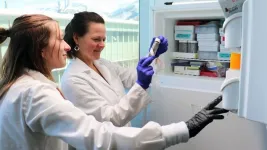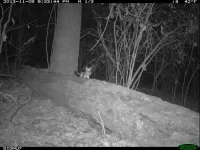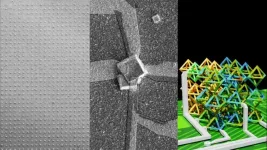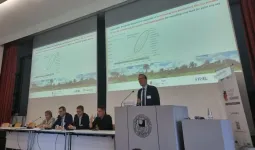(Press-News.org) LOGAN, UTAH, USA — Morphology is the study of the form and structure of organisms, including their physical characteristics such as shape, size and arrangement of parts. Morphology is key to taxonomy, the science of classifying organisms, as scientists use morphology to identify and study species, as well as to explore evolutionary processes.
Identifying species is challenging — even with large animals and plants, says Utah State University ecologist Norah Saarman.
“Trying to visually identify different species in small organisms such as mosquitoes is extremely difficult, as the species are very similar and their body parts are so tiny,” Saarman said. “Even with magnification and training, efforts to accurately identify a specific species are often inconclusive.”
Yet accurate identification is crucial in attempts to identify disease vectors and how to control their spread.
To this end, Saarman, assistant professor in the Department of Biology and USU Ecology Center, was awarded a $54,000 grant from the American Mosquito Association Research Fund toward her efforts to develop tools for efficient, low-cost and accurate identification of Culex mosquito vectors of West Nile Virus using computer vision-based AI technology.
Utah isn’t among the worst U.S. states for mosquitoes, yet varied species make themselves at home in the Beehive state. Among these pesky fliers is the Northern House Mosquito, Culex pipiens, which can spread West Nile Virus and St. Louis encephalitis in humans, as well as avian malaria in birds and heartworm disease in dogs.
Newer to northern Utah is the Southern House Mosquito, Culex quinquefasciatus, also known as “Quinx,” which is very similar to Culex pipiens, is a vector for many of the same diseases and is better at spreading West Nile Virus. Quinx was first identified in southern Utah in the 1950s but has made its way to the Salt Lake City area in recent years.
“Southern House Mosquitoes are a more effective vector of West Nile Virus because they are more likely to bite mammals and transmit the virus from birds to mammals,” Saarman says. “They are also a public health concern because they are known to be more capable of evolving resistance to commonly used insecticides.”
Additionally, Quinx breed with the Northern House Mosquito, producing hybrid populations.
“We need better identification tools to monitor populations of these insects, along with hybrid populations resulting from interbreeding,” Saarman says.
She has long collaborated with the Salt Lake City Mosquito Abatement District and the Utah Department of Health and Human Services to study and monitor the state’s mosquito populations. With mosquitoes collected and supplied by these entities, Saarman and her team members are refining methods of identifying species with morphological techniques and DNA testing. They’ll combine these methods with machine learning tools supplied by industry collaborator Vectech, Inc. to develop an AI method for identifying species with increased efficiency, accuracy and cost-effectiveness.
“Tracking mosquitoes and disease outbreaks is challenging, because mosquito populations rise and fall throughout the season, and they move and adapt quickly to changing conditions,” she says. “As Utah becomes increasingly urbanized, mosquitoes flock to welcoming habitats, such as storm drain catchment basins, unintentionally created by human developments.”
Mosquitoes need at least two things for survival: blood from vertebrate hosts and water. Try as you might to avoid these insects, your human blood and your animal companions, including dogs, cats and chickens, along with other wild animals attracted to human habitats such as squirrels, rats, mice and birds — as well as your human water-consuming habits — are irresistible attractions.
Saarman says female mosquitoes require a blood meal from a human, animal or bird to provide the energy needed to successfully lay their eggs directly on or near water. Even in arid regions, catch basins and storm drains, installed where humans reside and designed to collect runoff from creeks, streams and irrigation, create ideal breeding habitat for mosquito larvae.
“We think of Utah as a dry state and assume our hot summers will dry up pooled water, yet some infrastructure creates reservoirs of stagnant water — so small, you wouldn’t think they are problem — that are just right for mosquitoes,” she says.
Urban managers use larvicide, including Bacillus spaericus, to quickly wipe out mosquito larvae before they emerge to find blood hosts, yet judicious use is crucial.
“These larvicides are generally safe for humans, livestock, pets and non-target insects in managed doses,” Saarman says. “But mosquito larvae evolve a resistance to them. Being able to monitor the level of resistance, in which species it’s occurring and where it’s taken place is a management challenge. The ability to accurately and more quickly identify species will aid this challenge.”
Utah reported 14 West Nile Virus cases in humans, one resulting in death, in 2024, which might seem a small number.
“The Utah Department of Health and Human Services reports an average of 25 human cases per year in the state, and we shouldn’t overlook a surge of 158 cases logged during a high transmission event in summer 2008,” Saarman says. “Even in years with few cases, West Nile Virus is a serious neuroinvasive disease that can progress to dangerous and lingering complications, including meningitis, encephalitis and Acute Flaccid Paralysis.”
She and her team’s focus is on preventing vector-borne disease in the safest, most cost-effective and environmentally friendly ways possible.
“Doing that means we need to know which species we’re dealing with and the pathogens they’re infected with as soon as possible,” Saarman says. “The power of AI will help us achieve this.”
###
END
Roughly one out of three women ages 14-49 in the United States develop a vaginal bacterial imbalance known as bacterial vaginosis (BV) during their lifetime. BV is characterized by unpleasant odors, and potentially painful side effects, as well as the risk of associated health issues later in life. More than half of the patients who seek medical care do not respond to the first-line treatment, the antibiotic metronidazole, leading to recurrence.
Now Drexel researchers have developed ...
PHILADELPHIA – The members of the American Association for Cancer Research (AACR) have elected Keith T. Flaherty, MD, Fellow of the AACR Academy, as the AACR President-Elect for 2025-2026. Flaherty will become President-Elect on Monday, April 28, during the AACR’s Annual Business Meeting of Members at the AACR Annual Meeting 2025 in Chicago, Illinois and will assume the Presidency in April 2026 at the AACR Annual Meeting in San Diego, California.
Flaherty is director of clinical cancer research and the Richard Saltonstall Endowed Chair in Oncology at Mass General Cancer Center, ...
URBANA, Ill. — AI is changing the way we work, create, and share information — but brownies? A new study from the University of Illinois Urbana-Champaign explores how ChatGPT can be used in the sensory evaluation of foods, specifically brownies. The study offers insights that could streamline development of new products, and possibly enhance recipes moving forward.
But, why use AI for brownie tasting? Most people would gladly line up to sample chocolatey treats. However, in the food industry, sensory evaluation is an essential yet rigorous and costly process. Companies ...
NEW JERSEY, March 27, 2025 — The American Heart Association and The Giants Foundation, the nonprofit organization of the New York Giants, gathered representatives from 12 local schools for cardiopulmonary resuscitation (CPR) and automated external defibrillator (AED) training on March 20 at MetLife Stadium. According to American Heart Association data, nearly 9 out of 10 people who experience cardiac arrest outside of a hospital die, in part because they do not receive immediate CPR more than half of the time. CPR, especially if performed immediately, can double or triple a person’s chance of survival.
“Early recognition and action in a cardiac emergency ...
When monitoring the health of mammal populations, scientists often use camera traps to observe the animals in their habitats. But weasels are so sneaky they’re rarely caught on camera – leaving scientists with questions about this population of predators.
“We’re a little worried about the weasels,” says Roland Kays, a research professor at North Carolina State University and scientist at the N.C. Museum of Natural Sciences. “We don’t see them very often, but it’s ...
The American College of Cardiology is proud to announce the recipients of the 2025 Distinguished Awards. The twenty-one recipients have made remarkable contributions to the cardiovascular professional, helping the ACC in its mission to transform cardiovascular care and improve heart health for all.
Awardees will be recognized during Convocation at the American College of Cardiology’s Annual Scientific Session (ACC.25) taking place March 29 – 31, 2025, in Chicago.
The 2025 Distinguished Award winners are:
2025 Bernadine Healy Leadership in Women’s Cardiovascular Disease
Malissa J. Wood, MD, FACC
2025 Distinguished Cardiovascular ...
The American College of Cardiology will honor three early career cardiologists with the Hani Najm Global Scholar Award Observership Program at ACC's Annual Scientific Session (ACC.25), taking place March 29 – 31, 2025, in Chicago.
Established in 2020 at the Saudi Heart Association’s Annual Conference, the Hani Najm Global Award Observership Program encourages and fosters the sharing of knowledge between international cardiology professionals, specifically early career cardiologists in the Middle East and Africa. Through its Observership Program, recipients have the opportunity to ...
Researchers at Columbia Engineering have for the first time used DNA to help create 3D electronically operational devices with nanometer-size features.
"Going from 2D to 3D can dramatically increase the density and computing power of electronics," said corresponding author Oleg Gang, professor of chemical engineering and of applied physics and materials science at Columbia Engineering and leader of the Center for Functional Nanomaterials' Soft and Bio Nanomaterials Group at Brookhaven National Laboratory.
The new manufacturing technique could also contribute to the ongoing effort ...
KENNEDY SPACE CENTER (FL), March 28, 2025 – Heart disease remains the leading cause of death in the United States, accounting for one in five deaths. The inability of damaged heart muscle tissue to regenerate makes heart disease difficult to treat, and end-stage heart failure patients have no choice but to join a long list of people waiting for a heart transplant. Researchers from Emory University are working to provide another option for such patients. To do this, the team took their research to a laboratory unlike any on Earth—the International Space Station (ISSInternational Space Station).
Chunhui ...
Fruits and plant extracts contain bioactive compounds that can help treat or prevent diseases. To characterize and understand their mechanism of action, researchers from universities and research institutions in Brazil and Germany have conducted independent but complementary studies.
Some of the results were presented at a lecture session on the future of food and nutrition research on March 25th during FAPESP Week Germany at the Free University of Berlin.
According to Ulrich Dobrindt, a professor at the University of Munich in Germany, medicinal plants contain different types of phytochemicals (natural ...



